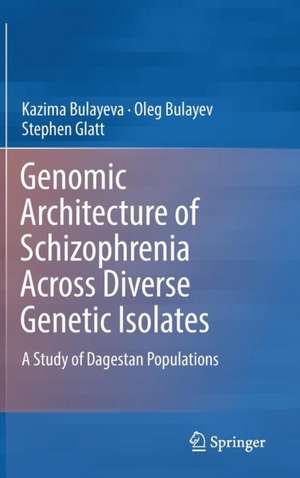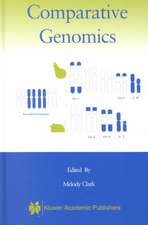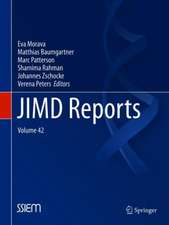Genomic Architecture of Schizophrenia Across Diverse Genetic Isolates: A Study of Dagestan Populations
Autor Kazima Bulayeva, Oleg Bulayev, Stephen Glatten Limba Engleză Hardback – 24 noi 2016
| Toate formatele și edițiile | Preț | Express |
|---|---|---|
| Paperback (1) | 1087.47 lei 6-8 săpt. | |
| Springer International Publishing – 22 iun 2018 | 1087.47 lei 6-8 săpt. | |
| Hardback (1) | 1094.25 lei 6-8 săpt. | |
| Springer International Publishing – 24 noi 2016 | 1094.25 lei 6-8 săpt. |
Preț: 1094.25 lei
Preț vechi: 1151.84 lei
-5% Nou
Puncte Express: 1641
Preț estimativ în valută:
209.40€ • 216.35$ • 174.19£
209.40€ • 216.35$ • 174.19£
Carte tipărită la comandă
Livrare economică 19 martie-02 aprilie
Preluare comenzi: 021 569.72.76
Specificații
ISBN-13: 9783319319629
ISBN-10: 3319319620
Pagini: 134
Ilustrații: XXVIII, 142 p. 50 illus., 35 illus. in color.
Dimensiuni: 155 x 235 x 11 mm
Greutate: 0.42 kg
Ediția:1st ed. 2016
Editura: Springer International Publishing
Colecția Springer
Locul publicării:Cham, Switzerland
ISBN-10: 3319319620
Pagini: 134
Ilustrații: XXVIII, 142 p. 50 illus., 35 illus. in color.
Dimensiuni: 155 x 235 x 11 mm
Greutate: 0.42 kg
Ediția:1st ed. 2016
Editura: Springer International Publishing
Colecția Springer
Locul publicării:Cham, Switzerland
Cuprins
1 Current Problems of Complex Disease Genes Mapping.- 2 Descriptions and Methods of Study in Selected Genetic Isolates of Dagestan.- 3 Selection of Populations for Mapping Genes of Complex Diseases.- 4 Mapping Genes of Schizophrenia in Selected Dagestan Isolates.- 5 Common Structural Genomic Variants in Linked with SCZ Regions.
Textul de pe ultima copertă
This book presents a long-term study in genetic isolates of indigenous small ethnics of Dagestan, located in the North-East part of Caucasus in Russia. Dagestan is characterized by extreme cultural and linguistic differences in a small geographic area and contains 26 indigenous ethnic groups. According to archeological data these indigenous highland ethnics have been living in the same area for more than ten thousand years. Our long-term population-genetic study of Dagestan indigenous ethnic groups indicates their close relation to each other and suggests that they evolved from one common ancestral meta-population. Dagestan has an extremely high genetic diversity between ethnic populations and a low genetic diversity within them. Such genetic isolates are exceptional resources for the detection of susceptibility genes for complex diseases because of the reduction in genetic and clinical heterogeneity. The founder effect and gene drift in these primary isolates may have caused aggregation of specific haplotypes with limited numbers of pathogenic alleles and loci in some isolates relative to others. The book presents a study in four ethnically and demographically diverse genetic isolates with aggregation of schizophrenia that we ascertained within our Dagestan Genetic Heritage Research Project. The results obtained support the notion that mapping genes of any complex disease (e.g., schizophrenia) in demographically older genetic isolates may be more time and cost effective due to their high clinical and genetic homogeneity, in comparison with demographically younger isolates, especially with genetically heterogeneous outbred populations.
Caracteristici
This volume represents a fitting compilation of decades of labor to dissect the genetic underpinnings of mental disorders that aggregate in distinct ethnic isolates
The book presents power and the promise of careful ascertainment, rich clinical characterization, and traditional family-based genetic analysis methods for discovering genomic loci that may harbor risk-conferring genes for mental disorders
The authors discuss the advantages of gene mapping in genetic isolates by using Schizophrenia gene mapping as an example
The book presents power and the promise of careful ascertainment, rich clinical characterization, and traditional family-based genetic analysis methods for discovering genomic loci that may harbor risk-conferring genes for mental disorders
The authors discuss the advantages of gene mapping in genetic isolates by using Schizophrenia gene mapping as an example






























